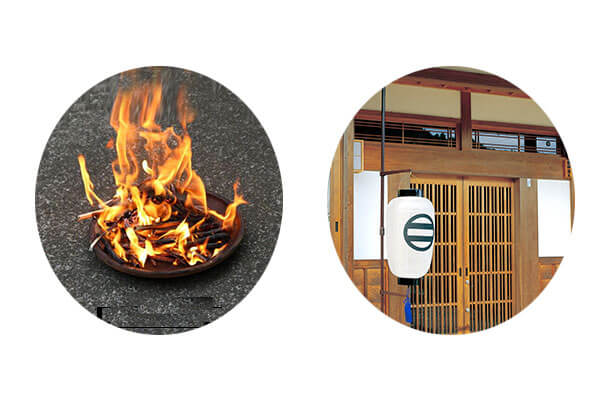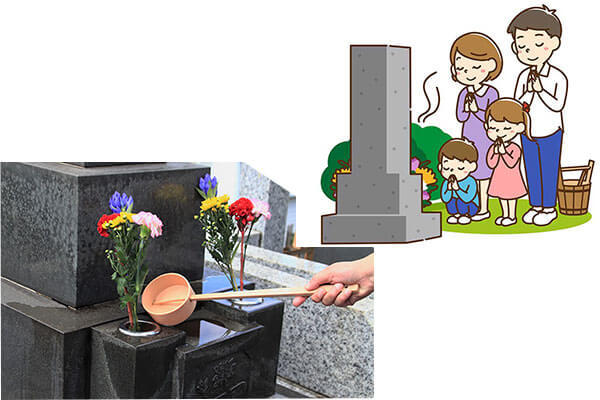Hi everyone how are you doing? Today’s theme is ” Obon (Festival of the dead) ” which takes place around the 15th of August.
Obon that is one of the biggest annual events in many parts of the country, which is from August 13th to 15th, however, it’s terribly pity that almost all festivals have to be canceled due to strong typhoon attacked the Japan islands in 2019.
Contents
What’s ” Obon (Festival of the dead) “?
Obon is an annual Buddhist event for commemorating one’s ancestors. It is believed that each year during obon, the ancestors’ spirits return from the Pure Land to the earthly realm in order to visit their families & relatives.
We welcome our ancestors into our homes, spend time together as a family, and then pray for their peaceful rest before holding a memorial service to honor their spirits.
Traditionally, to welcome our ancestors, we light welcoming fires so that they do not lose their way.
Alternatively, some use lanterns instead of fires. lanterns are hung in front of houses to guide the ancestors’ spirits, graves are visited and food offerings are made at house altars and temples.
It is believed that our ancestors ride on spirit horses during their journeys to and from this world.
Therefore, we create horse and cow figures using cucumbers and eggplants.
Horses are faster than cows, so they ride horses when they come here, and because they are reluctant to leave, they ride cows when they return.
Things to do during Bon
The specific customs during Bon can vary among families, but generally, the following are observed:
★ Preparing a small altar or spirit shelf.
★ Making spirit horses with eggplants and cucumbers.
★ Offering food and decorations to the graves or Buddhist altars.
★ Lighting welcoming fires to greet the spirits.
★ Regularly placing offerings on the spirit shelf.
★ Lighting farewell fires to send off the spirits.
★ Some may also invite Buddhist monks to chant sutras. This ritual, called “Hoyo,” is a Buddhist ceremony performed to pray for the deceased’s well-being in the afterlife.
The most important aspect of Bon is to express gratitude to our ancestors and perform the memorial services with heartfelt sincerity.
As it is a unique Japanese tradition, when you experience the Bon period, try to feel and observe it firsthand.
The Obon week in mid August is one of Japan’s three major holiday seasons (alongside New Year and Golden Week), accompanied by intensive domestic and international travel activities and increased accommodation rates.
In recent years, travel activitiy in mid August has become somewhat more spread out and less concentrated, but it is still considerable on certain days.
What’s “Toro Nagashi” (floating lanterns flow)?
Tōrō nagashi is a Japanese ceremony in which participants float paper lanterns down a river; tōrō is a word for “lantern,” while nagashi means “cruise” or “flow.”
At the end of Obon, therefore, floating lanterns are put into rivers, lakes and seas in order to guide the spirits back into their world. The customs followed vary strongly from region to region.
This activity is traditionally performed on the final evening of the Bon Festival in the belief that it will help to guide the souls of the departed to the spirit world.
The ceremony may take place on other days of the year for such reasons as the commemoration of those lost in the bombing of Hiroshima and those who died on Japan Airlines Flight 123.
It is also performed in other regions of the world, such as Hawaii, to commemorate the end of World War II.
The Bon Festival takes place on the thirteenth to fifteenth (but some place,sixteenth) of August or July, depending on the calendar used mentioned before.
Traditional Japanese beliefs state that humans come from water, so the lanterns represent their bodies returning to water and in particular to the sea. White paper lanterns are used to represent those who died in the past year.
What’s Awa Odori ?
Let’s take one example of Tokushima-ken’s case,
Every year in August, the city of Tokushima, Tokuhshima Prefecture on the island of Shikoku becomes one big dance floor, as 10,000 people dance through the streets.
Called Awa Odori, this is one of Japan’s annual Obon events to honour the spirits of ancesotors.
The ritual which Awa Odori is based on is still practised in a fishing community in Tokushima.
Those who have lost a family member within the past year gather at the port.
This straw doll is said to act as a magnet for the souls of the departed.
People believe that facing the sea and calling out the names of the dead will bring their souls back to this world.
Then lively festival music is played. The participants form a circle and start dancing. This dance expresses the joy of having the ancestral spirits back for brief while.
For further information on Awa Odori, please visit Awa Odori, thanks
A special table is set up for the spirits, and offerings of food and drink are placed on it. It’s customary to treat the spirits as if they were still alive.
Kyoto’s Gozan no Okuribiceremonial bonfire (seeing off the spirits on the final night of O-Bon)
On the last day of Obon-August the 16th, fires are lit to send the spirits back to the world of the dead. One of the grandest send-off displays is Kyoto’s Gozan no Okuribi.
The sticks of firewood used for the bonfires are offerings on which people have written messages to their ancestors.
Torchbearers climb up the hillsides carrying torches blessed by Buddhist priests, and light one pile of firewood after another.
Here, we see an ideogram on the hillside-bright and magnificent. These bonfires are thought to help guide the spirits back to their world.
These events and proctices related to Obon provide a glimpse into the Japanese outlook on life and death, which is base on the notion that people should alway give a warm welcome to the spirit of the deceased.

General people enjoy dansing around the “Bon Odori Stage”

There are some festivals around the world that are similar to Obon in some ways. For example:
Mexico’s Day of the Dead (Día de los Muertos) is a celebration of the deceased loved ones that takes place from October 31 to November 2. People create altars with photos, flowers, food and other offerings for the spirits, and visit cemeteries to decorate the graves and share stories.
China’s Ghost Festival (Zhongyuan Festival) is a Buddhist and Taoist festival that falls on the 15th day of the seventh lunar month, usually in August or September. It is believed that the gates of hell open during this time and the hungry ghosts roam the earth.
People make offerings of food, incense, paper money and other items to appease the ghosts and ancestors.
Cambodia’s Pchum Ben (Ancestors’ Day) is a 15-day festival that culminates on the 15th day of the tenth month in the Khmer calendar, usually in September or October.
It is a time to honor the dead, especially those who are trapped in the lower realms of existence.
People visit temples to offer food, prayers and merit to the spirits, hoping to free them from their suffering















Leave a Comment